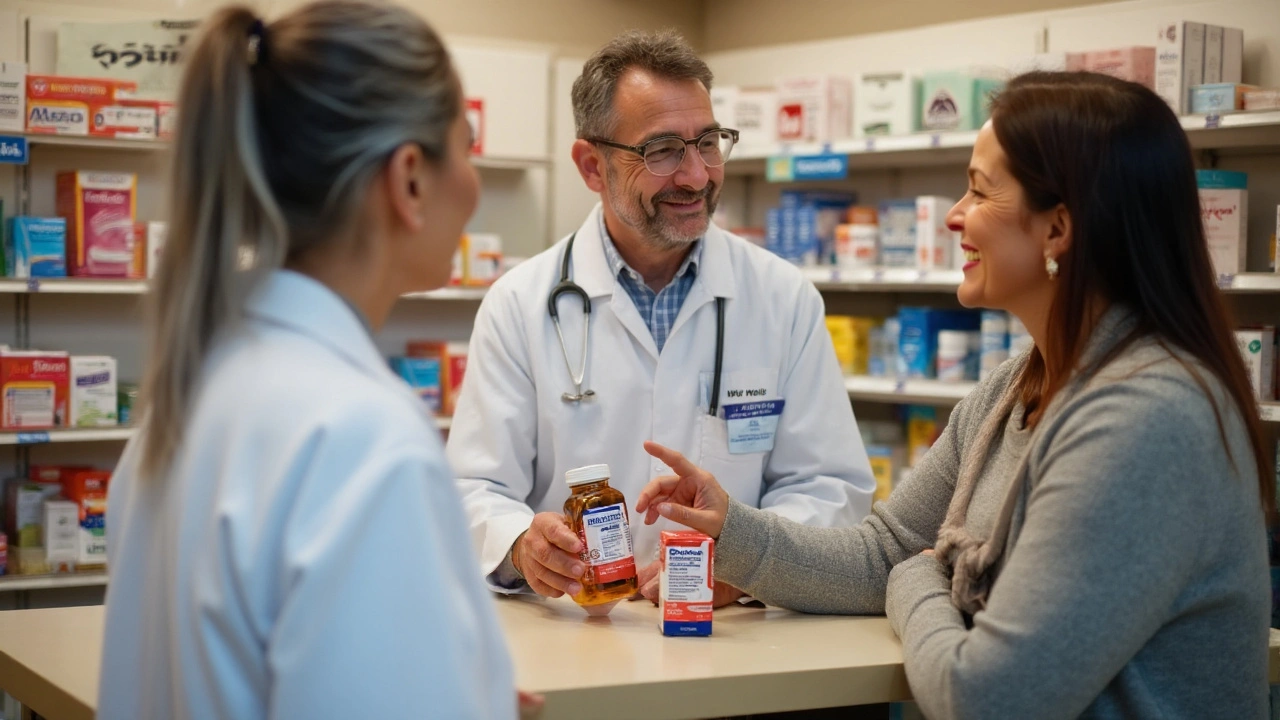Used well, self-medication saves time, money, and stress. Used poorly, it delays the care you actually need or causes side effects you didn’t bargain for. Here’s the simple promise: you’ll leave with clear rules for what you can treat at home, the red flags that mean “stop and get help,” and step‑by‑step guidance to do it safely. No scare tactics-just practical, evidence‑backed advice for real life in 2025.
TL;DR - The line on self‑medication, in plain English
- Okay to treat at home: short‑lived, mild problems you recognize (colds, seasonal allergies, heartburn less than 2 weeks, simple pain, mild diarrhea without blood, small skin irritations, minor sprains).
- Do not self‑treat: chest pain, trouble breathing, fainting, severe belly pain, uncontrolled bleeding, one‑sided weakness, severe headache “worst ever,” high fever that won’t break, blood in vomit/stool, stiff neck with fever, confusion, dehydration, pregnancy‑related bleeding, or any fast‑worsening symptoms.
- Time‑box it: if a home‑treatable issue isn’t clearly improving after 48-72 hours (or 24 hours for a fever in a baby under 2), switch to professional care.
- Read the label like a contract: don’t double up on the same active ingredient, know max daily doses, and watch for interactions with prescriptions or alcohol.
- Never self‑medicate with antibiotics, steroids, benzodiazepines, opioids, or someone else’s prescription-full stop.
Why trust this? It aligns with guidance from the World Health Organization on self‑care interventions, the U.S. FDA’s OTC drug monographs, CDC antibiotic stewardship principles, NICE (UK) primary care guidance, AAP dosing for kids, and ACOG safety notes for pregnancy.
The line: what’s safe to self‑treat-and what isn’t
If you clicked this because you want a firm line, use this simple traffic‑light system.
Green light-usually safe to self‑treat for a few days:
- Common cold or uncomplicated flu‑like illness without red flags (fever under 39°C/102.2°F, no breathing trouble, no chest pain).
- Seasonal allergies (itchy eyes, sneezing, clear runny nose).
- Headache you recognize (tension/migraine pattern) that responds to your usual OTC plan.
- Heartburn less than 14 days, not waking you nightly, not associated with unintentional weight loss or swallowing trouble.
- Mild diarrhea without blood, no severe cramps, no recent antibiotics, no high fever; focus on hydration.
- Minor sprains/strains, small cuts/abrasions, mild insect bites or rashes.
- Period cramps if they match your usual pattern.
Yellow light-caution, read labels, consider pharmacist advice:
- Adults over 65 or anyone on 5+ meds (higher interaction risk).
- Chronic conditions (heart, kidney, liver disease; diabetes; epilepsy) where OTCs can complicate things.
- Pregnancy or breastfeeding-many OTCs have specific timing/dose limits.
- Kids under 6-dosing is weight‑based; some meds aren’t safe at all.
- Symptoms that are mild but persistent (>2 weeks), even if not scary.
Red light-do not self‑medicate; seek urgent care:
- Chest pain, pressure, or pain radiating to arm/jaw; sudden shortness of breath.
- One‑sided weakness, facial droop, difficulty speaking, confusion.
- Severe or sudden “worst headache of my life.”
- Vomiting blood, black or bloody stool, persistent severe belly pain.
- High fever that won’t drop, stiff neck with fever, new rash with fever, or severe dehydration.
- Fainting, seizures (new or changed), severe allergic reaction (swelling, wheeze, hives with breathing issues).
- Pregnancy with bleeding, severe abdominal pain, or reduced fetal movement.
- Mental health emergencies: suicidal thoughts, psychosis, or violent agitation.
Hard stop items: antibiotics “leftover,” steroids, benzodiazepines, opioids, prescription sleep aids, and sharing any prescription. The CDC and every major regulator warn that misuse in these classes causes harm and drives resistance or dependence. There’s no safe “DIY” lane here.

How to self‑medicate safely: step‑by‑step and dosing guardrails
Think of this like a 7‑step checklist.
- Name the problem, not the product. “Sore throat + congestion, no fever” beats “I need a multi‑symptom syrup.” The clearer the symptom set, the fewer unnecessary ingredients you’ll take.
- Rule out red flags first. Use the lists above. If any red flag is present, skip the OTC aisle and get care.
- Open your meds list. Write down your prescription drugs, supplements, and allergies. Interactions hide in plain sight (examples below).
- Pick one active ingredient per symptom. Multi‑symptom combos often duplicate acetaminophen, antihistamines, or cough suppressants. Simple wins.
- Set a time box. Plan to reevaluate at 48-72 hours (24 hours for fevers in kids under 2). If you’re not clearly better, escalate.
- Use supportive care. Fluids, rest, oral rehydration, bland foods, salt‑water gargles, saline nasal spray. These are boring-and effective.
- Track what you took. Note dose, time, and response in your phone. It prevents accidental double‑dosing and helps your doctor if you need one.
Common OTC dosing and safety anchors (adults unless noted):
- Acetaminophen (paracetamol): Typical max 3,000 mg/day for most adults; absolute ceiling 4,000 mg/day with caution. Lower if you drink alcohol regularly or have liver disease. Kids: 10-15 mg/kg per dose every 4-6 hours (max 5 doses/24 h). Avoid mixing with cold/flu combos that also contain it.
- Ibuprofen: Up to 1,200 mg/day OTC (e.g., 200 mg every 4-6 hours). Take with food. Avoid if you have ulcers, kidney disease, severe heart disease, or in the last trimester of pregnancy. Kids: 10 mg/kg every 6-8 hours; not for infants under 6 months unless directed.
- Naproxen: Long‑lasting option; mind stomach and kidney risks similar to ibuprofen. Don’t combine NSAIDs together.
- Aspirin: Not for kids or teens under 19 due to Reye’s syndrome risk. Be careful if on blood thinners or with stomach issues.
- Decongestants: Pseudoephedrine works but can raise blood pressure and heart rate; avoid if you have hypertension or take MAOIs. In 2023, the FDA concluded oral phenylephrine is not effective as a nasal decongestant; don’t expect much from it.
- Antihistamines: Non‑drowsy options (cetirizine, loratadine, fexofenadine) are first‑line for allergies. Diphenhydramine can sedate and cause confusion in older adults-use sparingly.
- Cough: Dextromethorphan may help dry cough; avoid with SSRIs/SNRIs or other serotonergic drugs (serotonin syndrome risk). Guaifenesin thins mucus; hydration helps more.
- Heartburn: Famotidine (H2 blocker) for quick relief; proton pump inhibitors (omeprazole, etc.) are for frequent symptoms but limit to a 14‑day course unless your doctor says otherwise. New or ongoing symptoms beyond 2 weeks need evaluation.
- Diarrhea: Oral rehydration solution is the star. Loperamide can slow diarrhea; don’t use if there’s blood, high fever, or suspected food poisoning with toxin (worsening risk).
- Constipation: Polyethylene glycol or fiber supplements are gentle first choices. Avoid daily stimulant laxatives long‑term without guidance.
- Topical hydrocortisone 1%: Short courses (7-14 days) for mild rashes/itch. Don’t use on infected skin, face/eyelids, or broken skin without advice.
Interactions you really don’t want:
- Warfarin + NSAIDs (ibuprofen/naproxen) → bleeding risk. Ask before you take anything new.
- SSRIs/SNRIs + dextromethorphan, tramadol, or St. John’s Wort → serotonin syndrome risk (agitation, sweating, fast heart rate).
- MAOIs (rare but serious) + pseudoephedrine or certain cold meds → dangerous blood pressure spikes.
- ACE inhibitors/ARBs + potassium supplements or salt substitutes → high potassium.
- Alcohol + acetaminophen → liver strain; alcohol + sedating antihistamines → impaired driving and falls.
- Grapefruit juice + some statins or calcium channel blockers → increased drug levels (check your specific prescription).
Pregnancy and breastfeeding basics:
- Many people safely use acetaminophen, some antihistamines, and certain reflux meds during pregnancy, but timing matters. NSAIDs are generally avoided in the third trimester. Always confirm with your clinician or pharmacist.
- During breastfeeding, most common OTCs are compatible in small, label‑directed doses; still, double‑check because some can reduce milk supply (e.g., pseudoephedrine).
Sources behind these guardrails include FDA OTC monographs (updated through 2024), CDC medication safety and antibiotic use guidance, NICE Clinical Knowledge Summaries, the American Academy of Pediatrics dosing tables, and ACOG’s patient guidance on OTC use in pregnancy.
Real‑life scenarios and quick checklists
Scenario 1: The classic cold
You’ve got a runny nose, scratchy throat, and a low‑grade fever. No chest pain or shortness of breath. Safe plan: a non‑drowsy antihistamine during the day, salt‑water gargles, honey in tea for cough at night, and acetaminophen or ibuprofen for aches (not both NSAIDs together). Skip “multi‑symptom” syrups that duplicate ingredients. If you’re not clearly better by day 4-5 or you develop ear pain, wheeze, or high fever, check in.
Scenario 2: Heartburn after spicy dinner
Occasional burn? Try famotidine or a short 14‑day PPI course if it’s frequent. Elevate the head of your bed, skip late meals, ease back on alcohol. If heartburn persists beyond two weeks, or you notice trouble swallowing, weight loss, or black stools, that’s a medical visit.
Scenario 3: Headache the morning after
You had drinks last night. Today, you reach for pain relief. Choose ibuprofen with food if your stomach tolerates it, hydrate, and rest. Be conservative with acetaminophen if you drank more than a little-your liver does not want the combo. A headache that’s sudden, severe, or paired with confusion or stiff neck isn’t a hangover-get care.
Scenario 4: Mild diarrhea while traveling
Start with oral rehydration solution. If no blood or high fever and you’re not frail or immunocompromised, loperamide can help you get through the day. If symptoms are severe, bloody, or last more than 48 hours, seek care. After recent antibiotics, think C. difficile-don’t self‑treat; call in.
Scenario 5: Sprained ankle at the gym
Rest, ice, compression, elevation for 24-48 hours. Pain control with acetaminophen or an NSAID (not both NSAIDs). If you can’t bear weight, there’s bone tenderness, or swelling is severe, get an X‑ray. If you’re on blood thinners or have kidney disease, avoid NSAIDs unless cleared.
Scenario 6: Seasonal allergies flare
Start a once‑daily non‑drowsy antihistamine, plus a steroid nasal spray if needed (use correct technique; it’s about aiming away from the septum). Skip oral phenylephrine-it doesn’t help congestion. If you have glaucoma, high blood pressure, or prostate issues, avoid decongestants and ask for alternatives.
Scenario 7: Period cramps
Many get relief with NSAIDs at the first sign of cramps, plus heat. If cramps are way worse than usual, you’re soaking through pads hourly, or pain continues beyond the period, check in for causes like fibroids or endometriosis. If you’re trying to conceive or are pregnant, ask before using NSAIDs.
Checklist: Do/Don’t for safe self‑treatment
- Do read the active ingredient and the dose per unit.
- Do choose single‑ingredient products when possible.
- Do keep a simple log of what you took and when.
- Do time‑box: reassess at 48-72 hours.
- Don’t mix similar drugs (two NSAIDs, or two acetaminophen‑containing products).
- Don’t take someone else’s prescription, ever.
- Don’t chase sleep or anxiety with alcohol, cannabis, or leftover meds.
Home pharmacy essentials (2025)
- Acetaminophen; one NSAID (ibuprofen or naproxen).
- Non‑drowsy antihistamine; steroid nasal spray for allergies.
- Oral rehydration packets; loperamide; fiber supplement or polyethylene glycol.
- Hydrocortisone 1% cream; antibiotic ointment; bandages; digital thermometer.
- Saline nasal spray, honey (for adults/kids over 1 year), heat/cold packs.
Parents’ quick rules
- Fever in babies under 3 months: call immediately. Under 2 years: check in if fever lasts more than 24 hours or child looks unwell.
- Use weight‑based dosing for acetaminophen/ibuprofen; never give aspirin.
- Cold/cough combos aren’t recommended under 6 years; stick to fluids, saline, and comfort.
- Dehydration signs (dry mouth, no tears, fewer wet diapers) = prompt care.
Older adults and polypharmacy
- Default to the lowest effective dose and longest dosing interval.
- Avoid sedating antihistamines (confusion/fall risk).
- Check for drug interactions every time; pharmacists are your best friend here.
- New confusion, falls, or sudden weakness after any new OTC = stop and call.

FAQ + next steps and troubleshooting
Is it ever okay to use leftover antibiotics?
No. The CDC is blunt on this: leftover antibiotics are the wrong drug, the wrong dose, and the wrong duration-and they fuel resistance and side effects. Dispose of leftovers safely.
Can I alternate acetaminophen and ibuprofen?
Yes for short periods (like a tough fever), but log times and doses to avoid mistakes. Space each drug by its own dosing interval. If you need this for more than a day or two, check in.
Are herbal remedies safer because they’re natural?
Not automatically. St. John’s Wort can cancel out birth control and affect many meds. Kava can harm the liver. “Natural” doesn’t mean interaction‑free-run supplements by your pharmacist or clinician.
How long is it safe to use a PPI (omeprazole, etc.)?
For frequent heartburn, a 14‑day OTC course is standard. If symptoms return, don’t keep repeating cycles without an evaluation. Long‑term use can have downsides (nutrient absorption, infection risk) and should be supervised.
My cough won’t quit. When is it a problem?
If a cough lasts more than 3 weeks, or it comes with blood, weight loss, night sweats, chest pain, or breathlessness, get checked. Asthma, reflux, post‑viral cough, or medications (like ACE inhibitors) can play a role.
Can I take decongestants if I have high blood pressure?
Pseudoephedrine can raise blood pressure and heart rate. Many with controlled hypertension still avoid it. Consider saline, steroid nasal sprays, and non‑medicated options; ask your clinician for safe choices.
Is phenylephrine really ineffective?
The FDA concluded in 2023 that oral phenylephrine does not work as a nasal decongestant at standard doses. Don’t expect much from it. Topical sprays (used briefly to avoid rebound) or other strategies may help.
What about self‑medicating anxiety or sleep with alcohol or cannabis?
That’s not a safe plan. It can worsen anxiety/depression, disrupt sleep architecture, and create dependence. If stress or insomnia is frequent, try behavioral tools (sleep hygiene, CBT‑I apps) and talk with a clinician.
COVID, flu, or a cold-should I test or just treat?
If you’re high risk or you have close contact who is, testing early matters because antivirals for COVID and flu work best in the first 48 hours. If you’re low risk with mild symptoms, home care is reasonable-still, isolate if you might be contagious.
I’m pregnant. Which OTCs are “usually okay”?
Often‑used options include acetaminophen, certain antihistamines, and some reflux meds, but timing and personal history matter. NSAIDs are generally avoided in the third trimester. Get a quick pharmacist check before starting anything new.
Troubleshooting: different situations
- Student with a cold before exams: Pick cetirizine or fexofenadine (less sedating), saline spray, honey at night, acetaminophen for aches. Avoid diphenhydramine during the day.
- Shift worker with insomnia: Don’t lean on sedating antihistamines nightly. Try a strict wind‑down routine, dark room, and consistent wake time. If sleep stays broken, ask about CBT‑I or short‑term Rx under supervision.
- Parent with a feverish toddler: Confirm weight, dose acetaminophen or ibuprofen correctly, focus on fluids. If fever lasts beyond 24 hours in under‑twos, or the child seems listless or dehydrated, see a clinician.
- Older adult on warfarin with a new knee pain: Use acetaminophen first (within safe limits). Avoid NSAIDs unless your prescriber okays it.
- Traveler’s tummy: ORS first; loperamide if no blood/fever and you need to function. If you’re frail, immunocompromised, or symptoms persist beyond 48 hours, seek care.
- Heartburn that keeps bouncing back: One 14‑day PPI course, then a medical review if it returns. Don’t stack courses back‑to‑back without evaluation.
If things aren’t improving
- Past the time box (48-72 hours) without clear improvement? Escalate to a clinician or telehealth.
- New side effect after starting an OTC? Stop the drug and call for advice.
- Accidental overdose or a child ingested a medicine? Call poison control immediately.
- Can’t get an in‑person slot? Use telemedicine, urgent care, or ask a pharmacist for same‑day guidance.
- Bring your list. A written meds/allergy list speeds safe decisions.
Final thought: Self‑care is part of healthcare, not a substitute. Use it to handle the small stuff confidently, and respect the stop signs when your body tells you this is bigger. That’s the real line.

